Buick Century
| Buick Century | |
|---|---|
|
| |
| Overview | |
| Manufacturer | General Motors |
| Model years |
|
| Body and chassis | |
| Class |
|
| Body style |
|
| Chronology | |
| Predecessor | Buick Master Six |
| Successor |
|
Buick Century is the model name used by Buick for a line of upscale performance cars from 1936 to 1942 and 1954 to 1958, and from 1973 to 2005 for a mid-size car.
The model name Century came about when Buick was designing its first production automobile capable of reaching a speed of 100 mph (161 km/h). The division needed to come up with a name. One of the Buick executives had returned from a recent trip to Britain, and told the other executives that the British referred to going 100 mph as "doing the century". The executives liked the Century name and it stuck.
Series 60 (1930-1935)
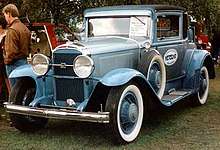
Originally the Series 60 had a six-cylinder 331.4 cu in (5,431 cc) engine, developing 99 bhp (74 kW) at 2,800 rpm. It had, at the beginning of the generation, a full length running board denoting the top model for Buick at the time. In 1930, GM built 38,180 cars. The bodystyles available were torpedo, sedan, coupe, and roadster convertible, using GM's "B-body" platform.
In 1931 the running board was reduced and a new straight eight-cylinder 272.6 cu in (4,467 cc) engine and 90 bhp (67 kW). Aesthetically, the Series 60 remained almost unchanged and the same fact occurred also in the following year. In 1931 and 1932 they were produced 55,135 examples.
In 1933 the length of the body increased. The engine power increased to 97 hp (72 kW). In 1934 the appearance was discontinued to a more rounded appearance, with a new 278.1 cu in (4,557 cc) eight-cylinder engine and 100 hp. In 1935 the model remained almost unchanged. From 1933 to 1935 the car were produced 31,385 copies. In 1936 the model changed its name to "Century".
First generation (1936–1942)
| First generation full-size Century | |
|---|---|
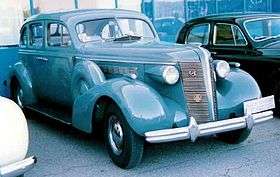 1937 Buick Century | |
| Overview | |
| Model years | 1936–1942 |
| Assembly |
Buick City, Flint, Michigan South Gate Assembly, South Gate, California |
| Body and chassis | |
| Class | Full-size car |
| Body style | 4-door sedan |
| Layout | FR layout |
| Platform | B-body |
| Related |
Cadillac Series 60 Cadillac Series 61 LaSalle Series 50 Buick Special Oldsmobile Series L Oldsmobile Series 70 Pontiac Streamliner Torpedo Pontiac Streamliner |
| Powertrain | |
| Engine | 320.2 in³ at 120 hp (89 kW) I8 |
Buick renamed its entire model lineup for the 1936 model year to celebrate the engineering improvements and design advancements over their 1935 models, introducing a "streamlined" appearance. Buick's Series 40 model range became the Special, the Series 80 became the Roadmaster and the Series 90—Buick's largest and most luxurious vehicles, became the Limited. The Century took the place of the Series 60.
The basic formula for the 1936 to 1942 Century was established by mating the shorter behind the engine cowl Special bodies to the Roadmaster's larger straight-eight engine (and consequently longer engine compartment). (In contrast the 1940 Series 50 Super would combine the larger Roadmaster body with the smaller Special engine.) While the Special was powered by Buick's 233 cu in inline-8 was rated 93 hp (69 kW) at 3200 rpm, Centuries produced between 1936 and 1942 were powered by the 320-cubic-inch producing 165 hp (123 kW), making them the fastest Buicks of the era and capable of sustained speeds of 100 mph (161 km/h), hence the name Century (100), earning the Century the nickname "the banker's hot rod."
The Century was discontinued at the end of the abbreviated 1942 model year, during which total model production only accounted for about ten percent of Buick's total output.
 1938 Buick Century
1938 Buick Century- 1938 Buick Century coupe
 1939 Buick Century
1939 Buick Century 1940 Buick Century coupe
1940 Buick Century coupe 1941 Buick Century
1941 Buick Century
Second generation (1954–1958)
| Second generation full-size Century | |
|---|---|
.jpg) 1955 Buick Century 4-Door Riviera | |
| Overview | |
| Model years | 1954–1958 |
| Body and chassis | |
| Class | Full-size car |
| Body style |
4-door sedan 2-door coupe 2-door convertible 4-door hardtop station wagon |
| Layout | FR layout |
| Platform | B-body |
| Powertrain | |
| Engine |
322 ci 4-bbl. 255hp V8[1] 364 ci V8 |
| Dimensions | |
| Wheelbase | 122"[1] |
| Length |
206.3"(1954) 206.7"(1955) 205.1"(1956) 208.4"(1957)[1] 211.8"(1958) |
| Width | 76"(1954–55) |
| Height |
60.5(1954) 59.8"(1956)[1] |
| Chronology | |
| Successor | Buick Invicta |
In 1954, Buick reintroduced the Century using the same formula of mating the smaller, lighter Buick Special body to its largest and most powerful 322 cubic inch V8 engine with the intent of giving Buick a performance vehicle. Included in the model lineup during this period was a station wagon model, a body style that had been unavailable during the Century's first production period of 1936 to 1942.
Introduced in the middle of the 1955 model year the 4-door Buick Century Riviera along with the 4-door Special Riviera and the 4-door Oldsmobile 98 Holiday and 4-door 88 Holiday, were the first 4-door hardtops ever produced. This was the first time "VentiPorts" appeared on the Century, a carryover from the Buick Roadmaster.
In 1955, the California Highway Patrol placed a large fleet order for Century 2-door sedans, a body style unavailable to the general public. It combined the Special 2-door sedan body shell with Century powertrain and trim. Broderick Crawford was shown driving a 2-door Century sedan during the first season of his popular syndicated TV series Highway Patrol. (In later seasons he'd drive a four-door Century, like his real life counterparts in the California Highway Patrol.) Power brakes were optional.[2] Tubeless tires were new.[3]
The Century remained Buick's performance line, with engine power rising from 200 (SAE gross) in 1954, to 236 in 1955, to 255 in 1956, and topping out at 300 from a bored-out 364 cu in (6.0 L) engine in 1957–58, the last model years for the full sized Century line.
In 1956 the Century's base price was $2,963. Power windows were standard in the convertible. A padded safety dash became optional.[4]
Because the Century was considered the senior "small Buick", the model received GM's only hardtop station wagon, the Century Caballero, from 1957 through 1958. The Caballero proved expensive to manufacture and unpopular with customers (only 14,642 produced for both model years), so GM did not bring it back for 1959.
For 1959, Buick renamed the Century the Invicta.
 1955 Buick Century Riviera coupe
1955 Buick Century Riviera coupe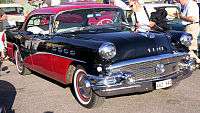 1956 Buick Century Riviera
1956 Buick Century Riviera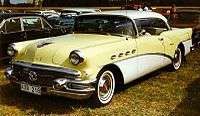 1956 Buick Century Riviera coupe
1956 Buick Century Riviera coupe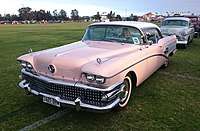 1958 Buick Century 2-Door Riviera
1958 Buick Century 2-Door Riviera.jpg) 1958 Buick Century 4-Door Riviera
1958 Buick Century 4-Door Riviera- 1958 Buick Century Convertible
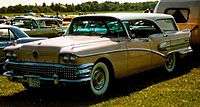 1958 Buick Century Caballero Estate
1958 Buick Century Caballero Estate
1969
In 1969, Buick created a dream car (concept car) known as the Century Cruiser, using futuristic design and features while recycling the Century name.
Third generation (1973–1977)
| Third generation | |
|---|---|
|
1973 Century Gran Sport Colonnade Hardtop Coupe | |
| Overview | |
| Model years | 1973–1977 |
| Assembly |
Flint, Michigan, United States Framingham, Massachusetts, United States Lakewood Heights, Georgia, United States |
| Body and chassis | |
| Class | Mid-size car |
| Body style |
2-door coupe 4-door sedan 4-door station wagon |
| Layout | FR layout |
| Platform | A-body |
| Related |
Buick Regal Oldsmobile Cutlass Pontiac Grand Prix Chevrolet Malibu |
| Powertrain | |
| Engine |
231 cu in (3.8 L) Buick V6 350 cu in (5.7 L) Buick V8 455 cu in (7.5 L) Buick V8 403 cu in (6.6 L) Oldsmobile V8 |
The Buick Century nameplate was revived for the 1973 model year on the rear-wheel drive intermediate A-body platform, which was redesigned for this year. The name replaced Skylark for Buick's mid-size cars. The Century Regal coupe was added at the top of the model range and would later become a separate series, dropping the Century name. It was available with two- and four-barrel versions of the Buick 350, putting out 150 and 175 hp (112 and 130 kW) respectively. The 225 hp (168 kW) 455 was also an option. The base Century and Century 350 coupes had a fastback roof with large rear quarter glass, while the Century Luxus featured a more formal notchback roofline with narrow opera windows.
By replacing the Skylark, the Century inherited the Gran Sport performance option. The package was available with any engine and included upgraded suspension, additional instrumentation, and unique appearance treatment. Dual exhaust increased output of the four-barrel 350 to 190 hp (140 kW). While the Stage I 455 was somewhat diminished from its performance heyday due to emission controls, output was competitive for the era at 270 hp (201 kW) and 390 lb⋅ft (529 N⋅m). A Saginaw three-speed manual was standard with either 350 engine. A Muncie M-21 four-speed was available with either 350 or with the regular 455, while the Stage I required a Turbo-Hydramatic 400.[5]
.jpg)
For 1975, the Luxus was renamed Century Custom. The new 110 hp (82 kW) 231 V6 was installed as standard equipment along with a three-speed manual transmission on coupes and sedans, and the big-block 455 was no longer available. The four-barrel 350 V8 became standard on station wagons. A new landau top became available for fastback coupes that partially covered the rear quarter glass, giving an appearance similar to the formal-roof Century Custom. A Century Special coupe was added to the lineup, using the fastback roofline. The Special was marketed as an economy variant of the Century and was only available with the V6 engine.
In 1976, the US government legalized rectangular headlights (long commonplace in Europe), and Buick promptly added them to the Century, positioned side-by-side on coupes and stacked vertically on sedans. Sedans received a taller, more-formal grille while coupes got an angled, body-colored front end along with new bodyside sheetmetal that lacked the traditional "sweepspear". The Gran Sport option was discontinued.
In 1977, the V6 engine was revised to be even-firing, and a 403 cu in (6.6 L) Oldsmobile V8 was added as an option for station wagons.
Buick Centuries were used in the 1975 and 1976 Indianapolis Motor Speedway as Pace Cars. Buick introduced a 1975 Buick Century "Free Spirit" edition replica based on the Indy Pace Car for the public with patriotic graphic decals and the Buick Hawk on the hood. This 1975 vehicle had a transmission shifter on the floor with bucket seats and "Hurst Hatch" t-tops installed. The white exterior and blue/white interior was based on the 1975 two door sheet metal. The engine was a 350 v8, as opposed to the 455 v8 used on the Indy Pace Car. Alternatively, in 1976, Buick introduced the "Free Spirit" edition of the Indy Pace Car, it was downsized to the 1976 Special facelift sheet metal with a 231 V6. The original Indy Pace car had the turbocharged 231 V6. The replica featured a rakish silver, black, and red paint job with black interior. The vehicle had positive-traction differential.
Fourth generation (1978–1981)
| Fourth generation | |
|---|---|
 | |
| Overview | |
| Model years | 1978–1981 |
| Assembly |
Framingham, Massachusetts, United States Lakewood Heights, Georgia, United States |
| Body and chassis | |
| Class | Mid-size car |
| Body style |
2-door coupe 4-door sedan 4-door station wagon |
| Layout | FR layout |
| Platform | A-body |
| Related |
Buick Regal Oldsmobile Cutlass Pontiac Bonneville Chevrolet Malibu |
| Powertrain | |
| Engine |
196 cu in (3.2 L) Buick V6 231 cu in (3.8 L) Buick V6 265 cu in (4.3 L) Pontiac V8 301 cu in (4.9 L) Pontiac V8 350 cu in (5.7 L) Oldsmobile diesel V8 |
| Transmission |
3-speed THM200, 250, 350 automatic 3-speed manual 4-speed Saginaw manual |
| Dimensions | |
| Wheelbase | 108.1 in (2,746 mm) |
| Length | 196 in (4,978 mm) |
| Curb weight | 3130-3425 lb |
In 1978, GM downsized its intermediate line, reducing wheelbase by four inches and curb weight by nearly half a ton. The Century name was now applied to the entire range except for the coupe, which retained the Regal name. A fastback coupe ("aeroback") and aeroback sedan were added (the body was shared with the Oldsmobile Cutlass Salon). It was also offered as a station wagon and two- and four-door notchbacks. The car was over a foot shorter, several inches narrower, and several hundred pounds lighter than its predecessor. V6 engines were still standard due to fuel economy regulations. Big block engines were gone and the new base powerplant was Buick's new 196 cu in (3.2 L) V6, introduced specifically for the Century and Regal. The 231 cu in (3.8 L) V6, and the Chevrolet 305 V8 were options. The Pontiac 265 cu in (4.3 L) and 301 cu in (4.9 L) replaced the Chevrolet engine for 1979.
One of the more rare models of this time was the 1979 to 1980 Century Turbo Coupe, powered by a turbocharged version of the 3.8 L V6, which offered V8-like performance with more reasonable fuel consumption and reduced emissions. The Turbo Coupe was not nearly as popular as the similar Regal Turbo Sport Coupe of the time, and total production is estimated to be less than 2,500.
The two fastback models (along with the Oldsmobile Cutlass Salon) proved unpopular. With the introduction of the new front wheel drive Century in 1982 (see below), the existing notchback sedan and wagon models were transferred to the Regal line.
Fifth generation (1982–1996)
| Fifth generation | |
|---|---|
|
| |
| Overview | |
| Also called | Chevrolet Century (Venezuela) |
| Model years | 1982–1996 |
| Assembly |
Oshawa, Ontario, Canada Oklahoma City, Oklahoma, United States Lakewood Heights, Georgia, United States Framingham, Massachusetts, United States Tarrytown, New York, United States Ramos Arizpe, Mexico, Valencia, Venezuela |
| Body and chassis | |
| Class | Mid-size car |
| Body style |
2-door coupe 4-door sedan 4-door station wagon |
| Layout | Transverse front-engine, front-wheel drive |
| Platform | A-body |
| Related |
Oldsmobile Cutlass Ciera Pontiac 6000 Chevrolet Celebrity |
| Powertrain | |
| Engine |
2.2 L LN2 I4 2.5 L Tech IV I4 2.8 L LE2/LB6 V6 3.0 L Buick V6 3.1 L L82 V6 3.3 L LG7 V6 3.8 L LG3 V6 4.3 L LT7 diesel V6 |
| Transmission |
GM TH-125C 3-speed automatic GM 440-T4 4-speed automatic GM 4T60-E 4-speed automatic |
| Dimensions | |
| Wheelbase |
104.8 in (2,662 mm) (1982–1990) 104.9 in (2,664 mm) (1991–96) |
| Length |
189.1 in (4,803 mm) (sedan & coupe) 190.9 in (4,849 mm) (wagon) |
| Width | 69.4 in (1,763 mm) |
| Height |
53.7 in (1,364 mm) (sedan & coupe) 54.1 in (1,374 mm) (wagon) |
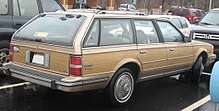
In January 1982[6], another downsized Century arrived, this time on the front wheel drive A platform, in coupe and sedan form. In October 1983, a station wagon was added to the lineup to replace the departed Regal wagon.[7][8] The 1984 model year also saw an Olympic version of the Buick Century, commemorating the 1984 games in Los Angeles, California. In 1985, all 1986 versions were "freshened" with a new, more angular front fascia. Wheelbase was 104.9 in (2,664 mm), with 189 in (4,801 mm) overall length. Both four-cylinder gasoline units and diesel V6 engines were offered in this generation, although neither became popular. Performance versions of several Buick models, including the Century coupe, were offered in the mid-1980s under the T-Type name. With Buick's 181 cu in (3.0 L) V6 producing 110 hp (82 kW), the Century T-Type's performance was modest, but the 3.8 SFI engine, producing 140–150 hp (104–112 kW), offered spirited performance in this comparatively lightweight vehicle.
For 1985 and 1986, Hess & Eisenhardt/Car Craft of Lima, Ohio converted 124 finished Buick Century coupes into coachbuilt convertibles. Although these convertibles were sold as new cars through Buick dealerships, these conversions were not factory authorized. In 1986, the engine distributor was replaced by a coil-pack ignition system that proved to be far more reliable than the system that it replaced. The Venezuelan-built models were sold as the "Chevrolet Century" in South America and the Caribbean. In Mexico, it was sold as the Century Limited (with no brand, although it wears the Buick logos). Introduced for 1984, it was the top model for General Motors Mexico, it survived successfully the import car wave from 1991 (previously new car importations were forbidden in Mexico) and continued in production until the 1996 model year.
1989 refresh
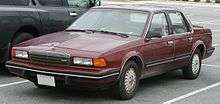
The Century received a facelift in late 1988 for the 1989 model year[9], gaining a new more-rounded roofline, but continuing on the A-body platform. Black plastic inserts with the Buick trishield emblem replaced the rear quarter windows. The front end received flush headlamps and a rounded grille, and the stand-up hood ornament was now standard. All sedan models were easily distinguished by their distinctive full-width taillights, a somewhat extravagant flourish on a smaller sedan, but one that carried on a Buick tradition of big taillights.The 3300 was introduced in 1989 as a lower-powered alternative to the 3800 cc power plant. The smaller engine featured multi-port fuel injection, waste spark distributor-less ignition controlled by the ECM after startup, but had no balance shaft. An interior refresh came in 1989 for 1990 models.[10]
1992 Facelift
In 1991 for the 1992 model year[11], the Century received another slight facelift featuring a bigger radiator grille and different headlamps. Also the interior received new door panels moving the window switches and door lock switches into a more convenient configuration found on more modern cars, where the switch location corresponds with the window location in the car body. This feature never appeared on its sibling the Oldsmobile Ciera, which retained the inline switch bank mounted flush with the door panel, the rear switch being the drivers door window. The Century windows switches were not backlit, but lit by a small bulb in the door panel trim above the switch bank. Other interior changes included new seat covers, and relocating the front outboard seat belts from the A pillar into the door, functioning as "automatic" seat belts so that the belts could be buckled and the door opened and closed while still buckled. The driver and front passenger could enter and exit the vehicle while the seat belt was still fastened.
For 1993,the 2.5 L I4 was replaced with a new 115 hp 2.2 I4. For 1994, the slow-selling coupe model was dropped (603 sold for 1993, or 0.5 percent of overall Century sales[12]), and all models received a standard driver's side airbag. Also in 1993, the 160 hp (119 kW) 3.3 L Buick V6 was replaced with a 3.1 L V6 with the same power rating, and power on the 2.2 L I4 was up to 120 hp (89 kW) with the introduction of MFI. Midway through the 1994 model year, a round speedometer replaced the wide rectangular one, but the car still carried on with the original dash.
Despite its dated design, the Century and its sibling the Oldsmobile Cutlass Ciera still sold well during the 1990s and proved both reliable and profitable to GM since their tooling costs had been monetized. In general, the A-body platform was very sturdy, and quality was improved every year while more standard features were added.
 1985 Buick Century coupe
1985 Buick Century coupe 1986–88 Buick Century sedan
1986–88 Buick Century sedan 1991–93 Buick Century sedan
1991–93 Buick Century sedan- 1994–96 Buick Century wagon
Engines
| Years | Engine | Power | Torque | Notes |
|---|---|---|---|---|
| 1982–1988 | 2.5 L (151 cu in) Tech IV TBI I4 | 90 hp (67 kW) | 134 lb⋅ft (182 N⋅m) | Also with 92 hp[13] |
| 1989–1992 | 2.5 L (151 cu in) Tech IV I4 | 110 hp (82 kW) | 135 lb⋅ft (183 N⋅m) | |
| 1993 | 2.2 L (134 cu in) LN2 I4 | 110 hp (82 kW) | 130 lb⋅ft (176 N⋅m)[14] | |
| 1994–1996 | 120 hp (89 kW) | 130 lb⋅ft (176 N⋅m)[15] | ||
| 1982–1985 | 3.0 L (181 cu in) Buick V6 | 110 hp (82 kW) | 145 lb⋅ft (197 N⋅m) | |
| 1986 | 2.8 L (173 cu in) LE2 V6 | 112 hp (84 kW) | 145 lb⋅ft (197 N⋅m) | |
| 1987–1988 | 2.8 L (173 cu in) LB6 V6 | 125 hp (93 kW) | 160 lb⋅ft (217 N⋅m) | |
| 1989–1993 | 3.3 L (204 cu in) LG7 V6 | 160 hp (119 kW) | 185 lb⋅ft (251 N⋅m) | |
| 1994–1996 | 3.1 L (191 cu in) L82 MFI/SFI V6 | 160 hp (119 kW) | 185 lb⋅ft (251 N⋅m) | |
| 1984–1985 | 3.8 L (231 cu in) LG3 V6 | 125 hp (93 kW) | 195 lb⋅ft (264 N⋅m) | MFI[13] |
| 1986–1988 | 150 hp (112 kW) | 200 lb⋅ft (271 N⋅m) | SFI | |
| 1982–1985 | 4.3 L (262 cu in) LT7 Diesel V6 | 85 hp (63 kW) | 165 lb⋅ft (224 N⋅m) |
Sixth generation (1997–2005)
| Sixth generation | |
|---|---|
 | |
| Overview | |
| Production | October 1996–2004 |
| Model years | 1997–2005 |
| Assembly | Oshawa, Ontario, Canada |
| Designer |
Wayne Cherry (chief: 1993) Wayne Kady (1993)[16] |
| Body and chassis | |
| Class | Mid-size car |
| Body style | 4-door sedan |
| Layout | Transverse front-engine, front-wheel drive |
| Platform | W-body 2nd Gen |
| Related | |
| Powertrain | |
| Engine |
3.0 L LW9 V6 (China) 3.1 L L82 V6 3.1 L LG8 V6 |
| Transmission |
4-speed 4T60-E automatic 4-speed 4T65-E automatic |
| Dimensions | |
| Wheelbase | 109.0 in (2,769 mm) |
| Length | 194.6 in (4,943 mm) |
| Width | 72.7 in (1,847 mm) |
| Height | 56.6 in (1,438 mm) |
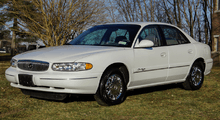
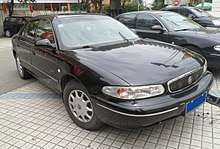
The Century was redesigned for the last time in December 1996.[17] The four-door sedan was the only body style offered (the station wagon was dropped due to decreasing sales), and was still a front wheel drive V6-powered configuration. Plainer "Custom" and fancier "Limited" trim levels were carried over from the previous generation. The redesign moved Centurys to the W-body platform, rejoining its former Regal sibling. In this generation, the Century and Regal were nearly the same car, distinguished only by seating configurations, trim, and engine differences. Since the Century was lower-priced than the Regal, it was also the lower-powered and plainer of the two, offering only a 3.1 L V6. In keeping with its traditional image, the 6-passenger Century came equipped with a front bench seat and column shifter, while the more performance-oriented 5-passenger Regal came standard with front bucket seats and console shifter. After the 1998 discontinuation of the Skylark, the Century for the first time became Buick's entry-level car. Buick tried to position the Century as a lower-priced alternative to Japanese family sedans like the Toyota Camry and Honda Accord. However, it failed to compete with them and was instead widely viewed as a car designed for an elderly target audience, an image not helped by the Century's assortment of senior citizen-friendly features like extra-large dashboard buttons and an extremely soft suspension. For 2003, all trim levels were eliminated, leaving one standard model. Additionally, the "Century" nameplate on the front doors was dropped, and only seen on the vehicle's taillights.
Changes were relatively few over the Century's nine-year run. The all-new Buick LaCrosse replaced both the Century and Regal. A limited run of Centurys with special trim were produced for 2005 to mark the end of the name. GM rolled the last Buick Century off the Oshawa assembly line on October 25, 2004.
The Buick Century was produced in China as the New Century from 1998 to 2000[18] and ran on the 3.0 litre LW9 V6 engine which was also used in the first generation Buick GL8. The Century was replaced by the Buick Regal due to poor sales.
Engines
References
- 1 2 3 4 Flory, Jr., J. "Kelly" (2008). American Cars, 1946-1959 Every Model Every Year. McFarland & Company, Inc., Publishers. ISBN 978-0-7864-3229-5.
- ↑ http://www.oldcarbrochures.com/static/NA/Buick/1955_Buick/1955_Buick_Brochure_1/1955%20Buick-26.html
- ↑ http://www.oldcarbrochures.com/static/NA/Buick/1955_Buick/1955_Buick_Brochure_1/1955%20Buick-24.html
- ↑ http://www.oldcarbrochures.com/static/NA/Buick/1956_Buick/1956_Buick_Brochure_1/1956%20Buick-29.html
- ↑ Fitzgerald, Craig (June 2004). "1973-1974 Buick Gran Sport". Hemmings Muscle Machines. American City Business Journals.
- ↑ https://www.nytimes.com/1981/09/14/business/new-cars-coming-gradually.html
- ↑ http://www.automobile-catalog.com/car/1984/314555/buick_century_estate_wagon_2_5l.html
- ↑ https://books.google.com/books?id=h9QDAAAAMBAJ&pg=PA110&lpg=PA110&dq=buick+century+wagon+%22october+1983%22&source=bl&ots=F2M8_SBh9S&sig=J4hY5tYrgvPLNVh058lR8xxa_vw&hl=en&sa=X&ved=2ahUKEwjKkcml1tfdAhUOlawKHQ6qDAsQ6AEwDnoECAIQAQ#v=onepage&q=buick%20century%20wagon%20%22october%201983%22&f=false
- ↑ https://newspaperarchive.com/hutchinson-news-oct-14-1988-p-61/
- ↑ https://books.google.com/books?id=214EAAAAMBAJ&pg=PA108&lpg=PA108&dq=%22november+1989%22+1990+%22buick+century%22&source=bl&ots=aTH1VHt-oH&sig=ZK7-0WS7qB-CtwYru3cn-jl40J4&hl=en&sa=X&ved=2ahUKEwjZgJOF3NfdAhUBQawKHSUxDPsQ6AEwC3oECAUQAQ#v=onepage&q=%22november%201989%22%201990%20%22buick%20century%22&f=false
- ↑ https://newspaperarchive.com/syracuse-herald-journal-sep-24-1991-p-111/
- ↑ Gunnell, John (2004). Standard Catalog of Buick, 1903–2004 (3rd ed.). Iola, WI: Krause Publications, Inc. p. 279. ISBN 0-87349-760-0.
- 1 2 Lösch, Annamaria, ed. (1984). World Cars 1984. Pelham, NY: L'Editrice dell'Automobile LEA/Herald Books. p. 271. ISBN 0-910714-16-9.
- ↑ Gunnell 2004, p. 280.
- ↑ Gunnell 2004, p. 285.
- ↑ http://www.autonews.com/article/19960923/ANA/609230719/cherry:gm-design-plan-is-driven-by-customers
- ↑ http://www.chicagotribune.com/news/ct-xpm-1996-08-11-9608110276-story.html
- ↑ "Spotted in China: Buick New Century".
External links
| Wikimedia Commons has media related to Buick Century. |
Buick, a marque of General Motors, automobile timeline, United States market, 1940s–1970s — next » | ||||||||||||||||||||||||||||||||||
|---|---|---|---|---|---|---|---|---|---|---|---|---|---|---|---|---|---|---|---|---|---|---|---|---|---|---|---|---|---|---|---|---|---|---|
| Type | 1940s | 1950s | 1960s | 1970s | ||||||||||||||||||||||||||||||
| 6 | 7 | 8 | 9 | 0 | 1 | 2 | 3 | 4 | 5 | 6 | 7 | 8 | 9 | 0 | 1 | 2 | 3 | 4 | 5 | 6 | 7 | 8 | 9 | 0 | 1 | 2 | 3 | 4 | 5 | 6 | 7 | 8 | 9 | |
| Subcompact | Opel | |||||||||||||||||||||||||||||||||
| Skyhawk | ||||||||||||||||||||||||||||||||||
| Compact | Special | Apollo | ||||||||||||||||||||||||||||||||
| Skylark | Skylark | |||||||||||||||||||||||||||||||||
| Mid-size | Special | Special | Century | Century | ||||||||||||||||||||||||||||||
| Skylark | Skylark | Regal | Regal | |||||||||||||||||||||||||||||||
| Full-size | Special | Special | Special | Special | LeSabre | LeSabre | LeSabre | LeSabre | LeSabre | |||||||||||||||||||||||||
| Century | Century | Invicta | Invicta | Wildcat | Centurion | |||||||||||||||||||||||||||||
| Super | Super | Super | Super | |||||||||||||||||||||||||||||||
| Roadmaster | Roadmaster | Roadmaster | Roadmaster | Electra | Electra | Electra | Electra | Electra | ||||||||||||||||||||||||||
| Full-size station wagon | Estate | Estate | Estate | |||||||||||||||||||||||||||||||
| Personal | Skylark | Riviera | Riviera | Riviera | Riviera | Riviera | Riviera | |||||||||||||||||||||||||||
« previous — Buick, a brand of General Motors, automobile timeline, United States market, 1980s–present | ||||||||||||||||||||||||||||||||||||||||
|---|---|---|---|---|---|---|---|---|---|---|---|---|---|---|---|---|---|---|---|---|---|---|---|---|---|---|---|---|---|---|---|---|---|---|---|---|---|---|---|---|
| Type | 1980s | 1990s | 2000s | 2010s | ||||||||||||||||||||||||||||||||||||
| 0 | 1 | 2 | 3 | 4 | 5 | 6 | 7 | 8 | 9 | 0 | 1 | 2 | 3 | 4 | 5 | 6 | 7 | 8 | 9 | 0 | 1 | 2 | 3 | 4 | 5 | 6 | 7 | 8 | 9 | 0 | 1 | 2 | 3 | 4 | 5 | 6 | 7 | 8 | 9 | |
| Subcompact | Skyhawk | |||||||||||||||||||||||||||||||||||||||
| Compact | Skyhawk | |||||||||||||||||||||||||||||||||||||||
| Somerset | ||||||||||||||||||||||||||||||||||||||||
| Skylark | Skylark | Skylark | Verano | |||||||||||||||||||||||||||||||||||||
| Convertible | Reatta | Cascada | ||||||||||||||||||||||||||||||||||||||
| Mid-size | Century | Century | Century | Regal | Regal | |||||||||||||||||||||||||||||||||||
| Regal | Regal | Regal | LaCrosse | |||||||||||||||||||||||||||||||||||||
| Full-size | LeSabre | LeSabre | LeSabre | LeSabre | Lucerne | |||||||||||||||||||||||||||||||||||
| Electra | Electra | Park Avenue | Park Avenue | LaCrosse | LaCrosse | |||||||||||||||||||||||||||||||||||
| Roadmaster | ||||||||||||||||||||||||||||||||||||||||
| Full-size station wagon | Estate | Roadmaster Estate | ||||||||||||||||||||||||||||||||||||||
| Personal | Riviera | Riviera | Riviera | |||||||||||||||||||||||||||||||||||||
| Subcompact crossover | Encore | |||||||||||||||||||||||||||||||||||||||
| Compact crossover | Envision | |||||||||||||||||||||||||||||||||||||||
| Mid-size crossover | Rendezvous | Enclave | ||||||||||||||||||||||||||||||||||||||
| Full-size crossover | Enclave | |||||||||||||||||||||||||||||||||||||||
| SUV | Rainier | |||||||||||||||||||||||||||||||||||||||
| Minivan | Terraza | |||||||||||||||||||||||||||||||||||||||
| Sports | Reatta | |||||||||||||||||||||||||||||||||||||||
Buick, a marque of General Motors, automobile timeline, Chinese market, 1999–present | ||||||||||||||||||||
|---|---|---|---|---|---|---|---|---|---|---|---|---|---|---|---|---|---|---|---|---|
| Type | 1990s | 2000s | 2010s | |||||||||||||||||
| 9 | 0 | 1 | 2 | 3 | 4 | 5 | 6 | 7 | 8 | 9 | 0 | 1 | 2 | 3 | 4 | 5 | 6 | 7 | 8 | |
| Supermini | Sail | |||||||||||||||||||
| Compact | Excelle | Excelle | ||||||||||||||||||
| Excelle GT | Excelle GT | |||||||||||||||||||
| Excelle HRV | Excelle XT | Verano Hatch/GS | ||||||||||||||||||
| Verano | ||||||||||||||||||||
| Velite 5 | ||||||||||||||||||||
| Mid-size | New Century/G-Series/Regal | Regal | Regal | |||||||||||||||||
| LaCrosse | ||||||||||||||||||||
| Full-size | Royaum | Park Avenue | ||||||||||||||||||
| LaCrosse | LaCrosse | |||||||||||||||||||
| SUV | Encore | |||||||||||||||||||
| Envision | ||||||||||||||||||||
| Enclave | ||||||||||||||||||||
| Minivan | GL6 | |||||||||||||||||||
| GL8 | GL8 | GL8 | ||||||||||||||||||